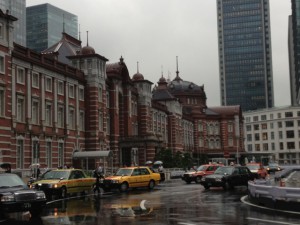ELSI Blog
23 Taxicab Culture in Tokyo and Manhattan2

Tokyo taxis
This blog is a continuation of Monday's piece. Once the ride is on, one will immediately notice a difference between NY and Japanese taxis. Enter a Japanese taxi and the starting fare will be roughly 600 yen. A NY taxi starts at a mere $2.50 (or 250 yen). Moreover each click on the meter will be 80 yen (80 cents) compared to 40 cents in NY. But the clicks are much faster in NY and when you add on the tip, the aggregate difference is not too significant. But it wasn't always that way. At the peak of Japan's Bubble Economy period in the late 80's, the fares in Tokyo were actually a bit higher than they are today, while NYC taxi fares were almost one half of today. Back then many foreign tourists in Japan felt absolutely crazy taking a taxi, while Japanese felt NYC fares were almost free. I wouldn't be the least bit surprised if the psychological aspects of this taxi fare differential weren't a key reason Mitsubishi Estate executives shelled out an insane $846 million for a 51% interest in New York's Rockefeller Center properties back in 1989. With NYC taxis so cheap, how could they lose? Another area which changed over the years in NY (but not in Japan) is taxi safety. In the 1970s, violent crime escalated in New York City, and many drivers gave up their profession. Bulletproof partitions went up, dividing drivers and passengers, and both sides were afraid of muggings. Nowadays NY taxis are nearly as safe as Tokyo's, yet in many cabs the old partitions still stand (tradition dies hard everywhere). Paying your fare through the little window is always a challenge in these cabs, getting change is worse. Passengers in Tokyo never experience these kinds of aggravations.
The nature of the driver corresponds well with the nature of the city. In Tokyo, the taxi drivers average 58 years old, 20 years older than they were last generation. A demographic crisis is looming. Yet gender and immigration could remedy this as taxi drivers are overwhelming male in Tokyo and, of course, almost entirely Japanese. Perhaps taxi reform is a good starting point for Prime Minister Abe's "Third Arrow". In fact this reform is already underway as there are some female drivers -- but, sadly, many of these upstanding women tend to be temporary drivers, as they are relatives of hung-over male drivers. And, if you can believe the talento TV shows, there are even a handful of foreign taxi drivers (mostly from Iran), but passengers are understandably shocked to encounter them.
The demographics of Manhattan cabbies mirror and evoke their city too. The days of Travis Bickle, the white ex-marine with mental illness, played by Robert De Niro in the 1976 classic film "Taxi Driver" are long gone. Immigrant drivers have long been the rule rather than the exception. Just as Manhattan is known as a melting pot, so too are its taxi drivers: you may encounter a Haitian, a Punjabi, an Ethiopian, or an Armenian national before riding with a deranged native New Yorker driver. A few years back a Hungarian driver gave my husband a detailed lesson in Eastern Europe's macro-economy that might have made George Soros reverse his bets. He was spot on too. I love hearing the stories of these immigrant drivers and what they left behind in their home countries, always reminding me of the allure of the United States from the outside eye.
With the two-decade plus recession, many Japanese drivers have pasts that they have left behind as well. Many of them lost their corporate jobs and then became drivers. Some one them share wistful tales of their salaryman heyday during the Bubble economy, where they traveled the world for their jobs. Now they travel the city's neighborhoods, in long shifts of riding alone for big portions of it. As colorful as NYC drivers can be, one shouldn't get the impression that Japanese drivers are boring. They are just more reserved and more thoughtful about the privacy of the passenger. Get a Tokyo cab driver going, and you can discover the best Hokkaido style ramen places open after midnight, the cheapest fishing boats to hire in Yokosuka Bay, the best neighborhood to buy your tchotchke-collecting aunt a fabulous present, or a stand-up bar where shots of shochu (Japanese vodka) sell for less than 200 yen. In fact, with some encouragement, I bet you can convince your driver to join you in these endeavors, which may be an interesting and legitimate way to get to know a slice of Tokyo!











